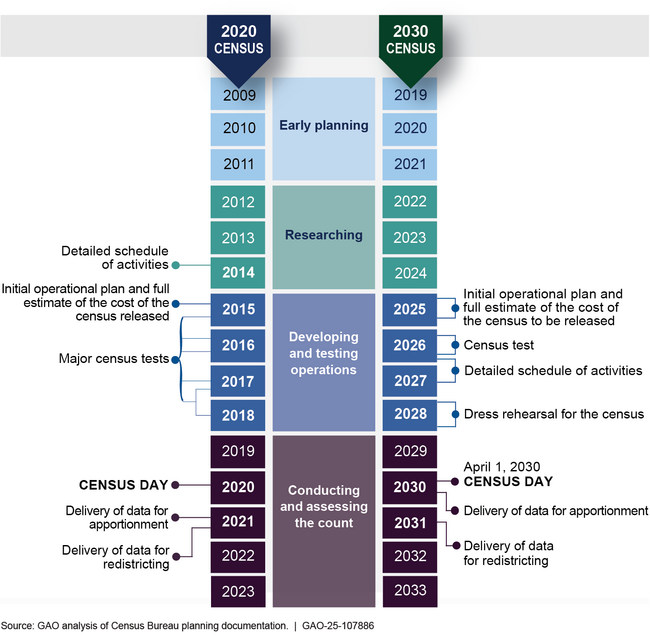2030 Census: Preparations Are Underway with Changes to How the Count Takes Place
Fast Facts
The Census Bureau has started planning for the 2030 Census.
The Bureau is planning to make several changes from previous decennial censuses. For example, it plans to start using machine learning to help build the nation’s list of addresses. It also plans to increase the use of administrative records to count people who don’t respond to the census. These and other changes could greatly reduce the number of households the Bureau needs to visit throughout the census.
We will continue to monitor these developments, as well as the transparency, data quality, and cybersecurity of the Bureau’s rollout of its planned changes.

A credentialed census worker approaches a house
Highlights
What GAO Found
The Census Bureau is currently developing its initial, high-level operational plan for the 2030 Census and estimating life-cycle costs. The plan will describe the Bureau’s census design and describe future testing intended to assess the viability of planned census activities. As of early July 2025, the Bureau has not yet publicly released the plan but intends to do so as soon as it is reviewed by the Department of Commerce.
The Bureau already completed much of its research and is planning major field tests for 2026 and 2028 that will further refine the plan as the agency transitions to conducting and assessing the census at the end of 2028 (see figure below).
The Census Bureau Has Begun Developing and Testing Operational Activities for the 2030 Census

The Bureau’s research and testing aims to improve the count for the 2030 Census. To assess the quality of past decennials and apply appropriate lessons learned toward improving future censuses, the Bureau received input from a wide range of stakeholders who provide recommendations for improvements. These recommendations can inform action plans, research and testing, and design decisions throughout the census planning life cycle.
While the 2030 Census design is based on that of the 2020 Census, the Bureau is planning several changes across many areas. These changes include downsizing address canvassing as a large scale field operation, increasing the use of administrative records to count persons who do not respond to the census, and leveraging data collection modernization and enterprise-wide IT system solutions to improve data products. If these plans are successful, the Bureau could greatly reduce the number of temporary census workers needed for follow-up with those not responding to the census, as well as the number of field offices needed to support them.
Developments since 2020 could also affect the types of data collected for the 2030 Census. For example, revisions to federal statistical standards and recent administration directives could affect data collection related to personal characteristics such as race, ethnicity, and citizenship. GAO will continue to monitor as the Bureau develops and submits its 2030 questionnaire content to Congress for review later in the decade.
Lessons learned from past censuses suggest themes for stakeholders to consider when reviewing these planned changes for 2030. GAO’s previous reporting on the 2020 Census highlights key themes for continued oversight:
- Budgetary uncertainty
- Cybersecurity and privacy
- Managing cost, schedule, and risk
- Data quality and transparency
Targeted oversight of 2030 Census planning across these themes can help ensure that the Bureau continues to sustain past progress and make improvements throughout the planning life cycle. The areas listed above prompt oversight questions such as:
- How is the Bureau planning to ensure resiliency of its key research and testing activities, as well as the evidentiary support for its design decisions, in an uncertain budgetary and staffing environment?
- How does the Bureau plan to address new and evolving cybersecurity threats for the 2030 Census and make related key decisions on IT systems and data privacy activities?
- How, if at all, will making certain design decisions later in the decade affect the Bureau's ability to manage the cost and schedule of the 2030 Census and what effects, if any, might such changes have on data quality?
Why GAO Did This Study
Census data are used to apportion the seats of the U.S. House of Representatives; support many private sector business decisions; redraw congressional districts in each state; and allocate hundreds of billions of dollars each year in federal financial assistance. GAO was requested by Congress to report on a range of topics related to preparations for the 2030 Census, including any effects from known major design changes. This report is the first in what will be a series of products on how the Bureau is preparing for the 2030 Census.
To identify the status of the Bureau’s planning for the 2030 Census as well as the known major changes to the 2030 Census from prior decennials, GAO reviewed preliminary operational planning documentation provided by the Bureau. GAO also identified design changes and compared timelines relative to the 2020 Census by analyzing its operational planning documentation. GAO selected the major changes to report based on their relationship to prior recommendations, the Bureau’s “enhancement areas” for the 2030 Census, or GAO’s biennial reporting on GAO’s High-Risk List.
To identify lessons learned from prior decennial oversight and how those lessons can inform future oversight, GAO reviewed reporting from GAO and the Department of Commerce Office of Inspector General on the 2020 Census and identified themes from recommendations and findings. GAO also collected and reviewed Bureau documentation of how it tracks and manages recommendations as it makes its 2030 design decisions.
For more information, contact Yvonne D. Jones at JonesY@gao.gov.
